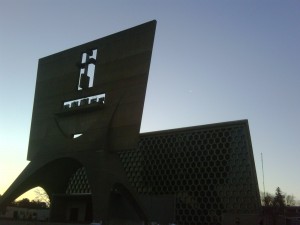 Struggling with Questions of Faith
Struggling with Questions of Faith
Just a short time after I post my blog I head out into the freezing bright air to St. John’s Abbey Church in Collegeville, Minnesota for morning prayers. I am going to the 7:00 a.m. service. The sun is not yet up, but a sliver of moon is shining.
It is not my first time to prayers at St. John’s. I have some idea of what to expect. I am still getting over a cold and laryngitis. I know that I will not be singing, but have no idea what a problem this will turn out to be. That is until I find myself feeling battered by the words, images and the sheer weight of thousands of years of church tradition.
St. John’s Abbey church is an amazing cavern with a multi-story wall of honeycomb shaped windows. Each pane is filled with abstract shapes and color. They grow more beautiful as morning light rises. However, this morning the beauty cannot outweigh the exclusivity and harm of the words and deeds of the tradition itself.
Just to be clear, this is not a story of concern or frustration with the Roman Catholic Church per se. It has many problems, as does every other form and expression of the Christian church. My response in this service is to the way words, music, and images of the service symbolize the church universal. It seems a window into the brokenness of the scriptural traditions and their misuse through history. I neither see nor want a place in those traditions as I sit surrounded by them.
It was not just that the language for God and humanity was virtually all in the masculine case. Although that is problem enough, leaving out half of humanity. But also there is a sense of the longevity of those words and the power they represent. The enduring character of religious traditions is both pervasively unwelcoming and beautifully inviting at the same time.
On this occasion I struggled to see or hear any beauty. I find myself deeply sad and frustrated. I feel somewhat paralyzed trying to write about it even now.
Like most significant and lasting relationships, I have a long and complicated one with Jesus and the church. I can’t in this one post recount or even summarize that relationship. But a few salient points are worth mentioning, because stories will convey far more than arguments or creeds.
Early in my life my relationship was characterized by simpler and mostly uncritical acceptance and love. As I told one friend earlier in the week, “You can’t grow up in my tradition (baptist) and not love Jesus. Of course I love Jesus!” Then I began to see increasingly how problematic Jesus and the church, which carried forward those traditions about Jesus, could be. So many terrible things have been done and continue to be done in the name of Jesus and the church from crusades and war to colonialism and sexual abuse. The list is long and depressing. At the same time I could see the liberating power of following Jesus for participating in the presence of God and the beauty and goodness in the world.
The struggle to hold these two views and my own heart and mind together began while I was in high school. My youth minister helped me understand that God could take our questions. We could shake our fist in God’s face, and not be rejected by God. Lament and protest are part of the tradition. We didn’t need to hide our doubts, disappointments or hurts from our relationship. God could take it. Jesus was fully human, not merely an apparition floating around the earth. The freedom to ask hard questions has probably saved my relationship with Jesus on too many occasions to remember. Those hard questions of the tradition were practiced by Jesus himself. Thank God. Asking is part of following.
For many years, since college, I have practiced belonging in the traditions which grew up around Jesus by changing the words of the music, prayers, confessions, and scriptures about Jesus. Sitting in St. John’s this week, I could not participate in this way, and it overwhelmed me to sit defenseless in the face of it all. This kind of participation was and remains a simple act of faith and faithfulness to my experience of God in Jesus, to name it more honestly in both my private and public forms of address.
It is not merely to recreate God or Jesus in my own image, although of course I surely do. Everyone who writes or talks about Jesus does . . . from the most renowned scholars to the smallest child. That is partly what relationships do. They are dynamic and they change everyone who participates.
To continue to struggle with the questions and continue practicing and participating in the tradition critically (just as Jesus was critical of his own received tradition), are among the important directions my life of faithfulness takes. These are practices of faith which may not sound faithful. They would not count as faithful in many quarters. However, I have looked for others and found communities where this living of the questions is the way of faith. This critical honest struggle with the tradition, this attempt to hold together the beauty and liberation while not forgetting the harm and oppression done in the name of Jesus, make for a rich and meaningful sense of faith community which reaches into every part of my life.
The experience I had sitting in the chapel goes straight to the heart of the question in my last blog: What are we going to do with Jesus? It is one of the questions with which we must struggle and engage together. There are not any easy answers. The responses we make to the question and way we share in the struggle with others can begin to make a life together that may in the end bear the fruit of faith.
And still there is more to say . . . as Advent unfolds and we practice welcoming Jesus again.



